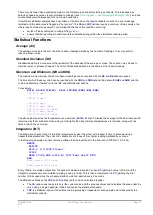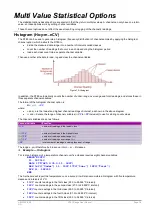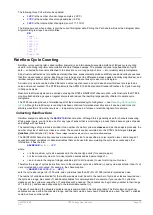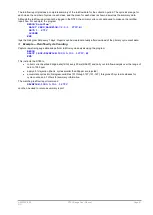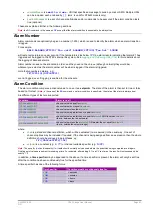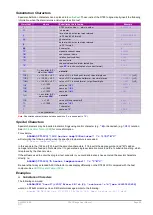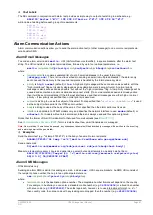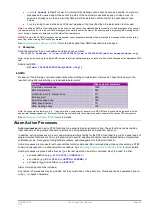
UM-0085-B09
DT80 Range User Manual
Page 91
RG
For example, the job:
BEGIN
1..3CV(W)=0
RA1S
1CV(W)=1CV+1
ALARM(1CV>3CV){XB 2CV(W)=2CV+1 3CV(W)=2^3CV}
RBX LOGONB
1..5TK
END
logs data at increasing intervals as the experiment proceeds. The program calculates the next log point as an
incrementing power of 2 seconds — that is, it logs the temperatures at t = 0, 1, 2, 4, 8, 16,… seconds. The following
table lists the values of the three CVs at the point at which the
ALARM
statement is executed.
Time (s)
1CV
2CV
3CV
0
1
0
0
Alarm active – B schedule polled
1
2
1
2
Alarm active – B schedule polled
2
3
2
4
3
4
2
4
Alarm active – B schedule polled
4
5
3
8
5
6
3
8
6
7
3
8
7
8
3
8
Alarm active – B schedule polled
8
9
4
16
etc.
(Remember that (1CV>3CV) means 1CV is greater than or equal to 3CV.)
The following example will log all voltage readings that exceed 200mV:
BEGIN
RA1S IF(2V(=1CV)>200){X}
RX 1CV("Vout~mV")
LOGONX
END
Note:
assigning to a CV in this way and then reporting the CV value is preferable to including 2V in both schedules. Alternatively, a
reference (&2V) could have been used.
Executing Commands in Schedules
The following will output a directory listing every time a positive edge is received on digital input 7:
RA7+E DO{DIR"B:"}
Selecting a Job to Run
The following schedule
RA1SERIAL""
1SERIAL("%1d",=1CV)
IF(1CV><0.5,1.5){RUNJOB"MIX"}
IF(1CV><1.5,2.5){RUNJOB"CHURN"}
IF(1CV><2.5,3.5){RUNJOB"GRIND"}
will run when a character is received on the serial sensor port. If the character is 1, 2 or 3 then the indicated job will be
loaded and run, replacing the current job.
Automatic Data Archive
The schedule command
RE1D DO{COPYD dest=a: sched=A start=new}
instructs the DT80 to — every midnight (1D trigger) — move all new data for schedule A to an archive file on the USB
memory device.

